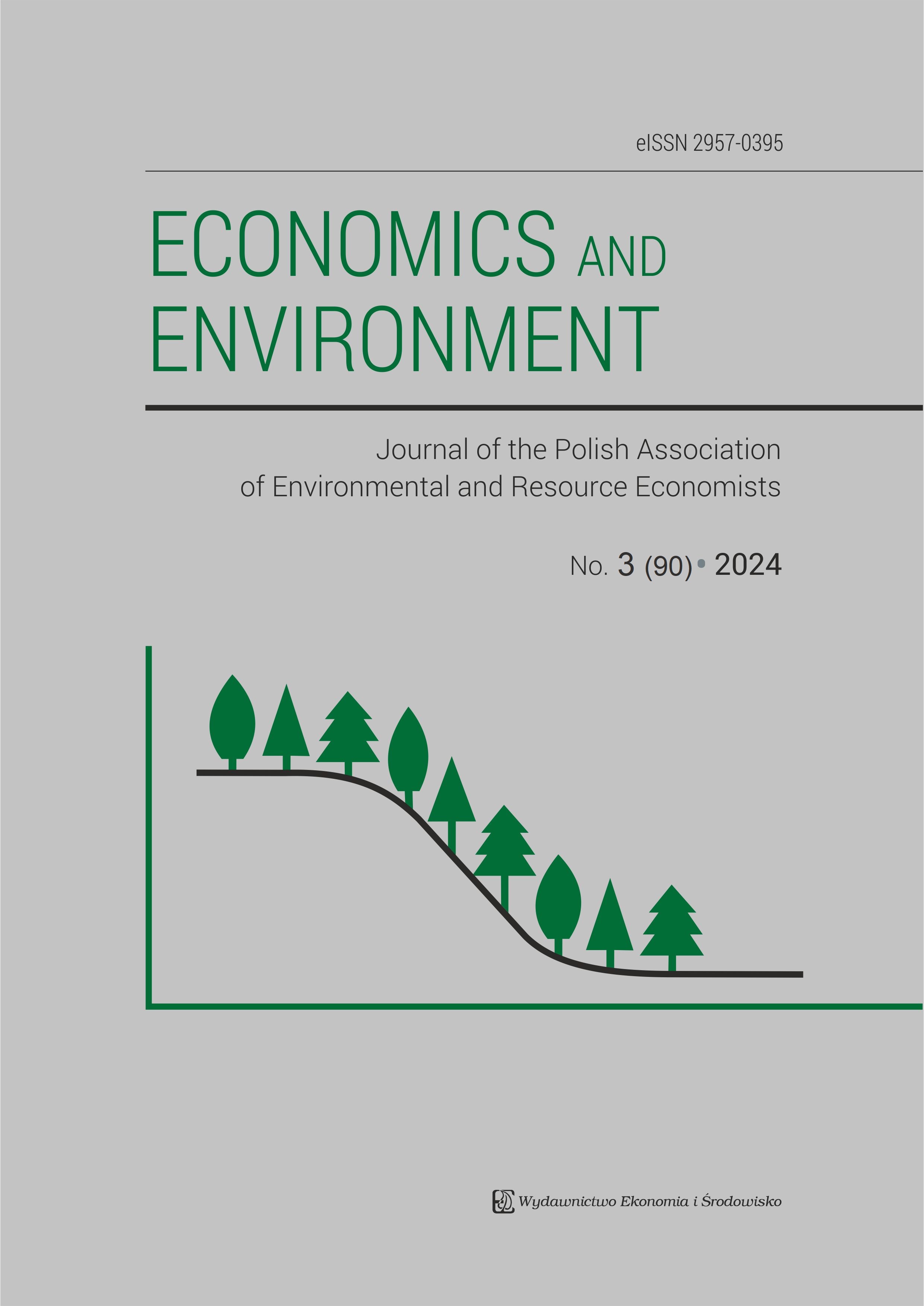Abstract
ABSTRACT: The objective of this article is to investigate behaviours related to electromobility in terms of owned vehicle fleets and charging stations in local administration units, the role of zero-emission vehicles in building the image of the administration and the promotion of environmentally friendly behaviours among its employees as at the end of 2022. The completion of the objective was based on surveys of the data collected using the CATI technique from provincial offices (POs) and municipal offices (MOs)[1] of provincial cities. The survey showed that the primary means of transport owned by the entities surveyed are internal combustion engine vehicles. Of these, the largest group is made up of passenger cars – the average age of vehicles at the time of the survey was approx. eight years. In sum, the local administration in the provincial cities is approaching the target value established by law. The average share of BEVs in the passenger vehicle fleet is 9%. In terms of charging station ownership, there were three dominant patterns. There is a perception among respondents that a fleet of environmentally friendly vehicles builds a positive, pro-environmental image of the office, while in none of the offices was there any action to support the environmentally friendly behaviour of employees in terms of travelling to and from work.
[1] The survey covered local government administrative units in 16 cities where local government offices are located and involved provincial local government offices (POs) and municipal local government offices (MOs).
References
Act from 11 January 2018. Act on electromobility and alternative fuels. Journal of Laws 2018, item 317. https://isap.sejm.gov.pl/isap.nsf/DocDetails.xsp?id=WDU20180000317 (in Polish).
Augustyn, A. (2020). Zrównoważony rozwój miast w świetle idei smart city. Białystok: Wydawnicwo Uniwersytetu w Białymstoku. (in Polish).
Brodowicz, D. P., & Stankowska, A. (2021). European Union’s Goals Towards Electromobility: An Assessment of Plans’ Implementation in Polish Cities. European Research Studies Journal, 24(4), 645-665. https://doi.org/10.35808/ersj/2613
Casini, M. (2017). Green technology for smart cities. Proceedings of the 2nd International Conference on Green Energy Technology, Rome, Italy, 83(1), 012014. http://dx.doi.org/10.1088/1755-1315/83/1/012014
Chiehyeon, L., Kwang-Jae, K., & Maglio, P. (2018). Smart cities with big data: Reference models, challenges, and considerations. Cities, 82, 86-99. https://doi.org/10.1016/j.cities.2018.04.011
Deloitte. (2024, May 17). Przyszłość mobilności. Transport i komunikacja przyszłości. https://www2.deloitte.com/pl/pl.html (in Polish).
Gil-Garcia, J. R., Chen, T., & Gasco-Hernandez, M. (2023). Smart City Results and Sustainability: Current Progress and Emergent Opportunities for Future Research. Sustainability, 15(10), 8082. https://doi.org/10.3390/su15108082
Hajduk, S. (2020). Modele smart city a zarządzanie przestrzenne miast. Gospodarka Narodowa. The Polish Journal of Economics, 302(2), 123-139. http://dx.doi.org/10.33119/GN/120626 (in Polish).
Janczewski, J. (2017). Determinanty rozwoju elektromobilności. Wybrane kwestie. Zarządzanie innowacyjne w gospodarce i biznesie, 25(2), 205-223. https://ziwgib.ahe.lodz.pl/sites/default/files/ZIwGiB_nr_2_2017_e-book.pdf (in Polish).
Joshi, S., Saxena, S., & Godbole, T. (2016). Developing Smart Cities: An Integrated Framework. Procedia Computer Science, 93, 902-909. https://doi.org/10.1016/j.procs.2016.07.258
Krawiec, S. (2016). Wyzwania dotyczące kształtowania zrównoważonej mobilności w miastach i aglomeracjach. Barometr Regionalny. Analizy i prognozy, 4(46), 129-138. (in Polish).
Krawiec, S., & Krawiec, K. (2017). Rozwój elektromobilności w Polsce. Uwarunkowania, cele i bariery. Studia Ekonomiczne. Zeszyty Naukowe Uniwersytetu Ekonomicznego w Katowicach, 332, 17-24. https://www.ue.katowice.pl/fileadmin/user_upload/wydawnictwo/SE_Artyku%C5%82y_321_340/SE_332/02.pdf (in Polish).
Letkiewicz, A. (2022). Sustainable Mobility Within Green Smart Cities – a Challenge for Local Governments. Case Study of Tri-City. Scientific Papers of Silesian University of Technology, Organization and Management, 167, 231-248. http://dx.doi.org/10.29119/1641-3466.2022.167.17
Letkiewicz, A., & Szulc, K. (2022). W kierunku green smart city - case study Trójmiasta. Contemporary Economy Electronic Scientific Journal, 13(1), 59-73. https://czasopisma.bg.ug.edu.pl/index.php/wg/article/view/6883/6212 (in Polish).
Lim, C., Kim, K. J., & Maglio, P. P. (2018). Smart cities with big data: Reference models, challenges, and considerations. Cities, 82, 86-99. https://doi.org/10.1016/j.cities.2018.04.011
Marcinkowski, T. (2023). Dylematy kryzysowe Unii Europejskiej: pandemia i zielony ład. Rocznik Integracji Europejskiej, (17), 207-220. https://doi.org/10.14746/rie.2023.17.13 (in Polish).
Melkonyan, A., Hollmann, R., Gruchmann, T., & Daus, D. (2024). Climate mitigation and adaptation strategies in the transport sector: An empirical investigation in Germany. Transportation Research Interdisciplinary Perspectives, 25, 101102. https://doi.org/10.1016/j.trip.2024.101102
Mierzejewska, L. (2015). Zrównoważony rozwój miasta–wybrane sposoby pojmowania, koncepcje i modele. Problemy Rozwoju Miast, 3, 5-11. http://cejsh.icm.edu.pl/cejsh/element/bwmeta1.element.desklight-3d0ba10f-da40-4be9-b514-591ffa2ce430 (in Polish).
Ministerstwo Energii. (2017). Plan Rozwoju Elektromobilności w Polsce „Energia do przyszłości”. https://www.gov.pl/attachment/7cbc60f4-fec6-4dc1-b950-548cb0e52e9e (in Polish).
Ministerstwo Klimatu i Środowiska. (2022). Przegląd Polityki Energetycznej Polski 2022. https://www.gov.pl/web/oecd/przeglad-polityki-energetycznej-polski-2022 (in Polish).
Motowidlak, U. (2020). Kierunki rozwoju mobilności niskoemisyjnej. Łódź: Wydawnictwo Uniwersytetu Łódzkiego. (in Polish).
NIK. (2020). Wsparcie rozwoju elektromobilności - Informacja o wynikach kontroli. https://www.nik.gov.pl/kontrole/wyniki-kontroli-nik/pobierz,kgp~p_19_020_201907231150301563875430~01,typ,kk.pdf (in Polish).
Nowak, Z. (2021). Europejski Zielony Ład–na drodze do neutralności klimatycznej UE. PISM. https://pism.pl/publikacje/Europejski_Zielony_Lad__na_drodze_do_neutralnosci_klimatycznej_UE (in Polish).
Parlament Europejski. (2023). Redukcja emisji gazów cieplarnianych: cele i przepisy Unii Europejskiej. https://www.europarl.europa.eu/topics/pl/article/20180305STO99003/redukcja-emisji-gazow-cieplarnianych-cele-i-przepisy-unii-europejskiej (in Polish).
Pomykała, A., & Raczyński, J. (2020). Europejski Zielony Ład dla Unii Europejskiej i jej mieszkańców. TTS Technika Transportu Szynowego, 27(12), 6-9. http://yadda.icm.edu.pl/baztech/element/bwmeta1.element.baztech-38284f62-9a1c-40da-8c41-552681e3e90c (in Polish).
Razmjoo, A., Nezhad, M. M., Kaigutha, L. G., Marzband, M., Mirjalili, S., Pazhoohesh, M., Memon, S., Ehyaei, M. A., & Piras, G. (2021). Investigating Smart City Development Based on Green Buildings, Electrical Vehicles and Feasible Indicators. Sustainability, 13(14), 7808. https://doi.org/10.3390/su13147808
Saeter, S. R. (2022). Mobility at the crossroads – Electric mobility policy and charging infrastructure lessons from across Europe. Transportation Research Part A: Policy and Practice, 157, 144-159. https://www.sciencedirect.com/science/article/pii/S0965856422000106
Szadziewska, A., Majchrzak, I., Remlein, M., & Szychta, A. (2021). Rachunkowość zarządcza a zrównoważony rozwój przedsiębiorstwa. Katowice: Instytut Prawa Gospodarczego. (in Polish).
Tota, P. (2017). Miasto inteligentne–miasto dostępne. Nowoczesne technologie miejskie w kontekście projektowania uniwersalnego. Środowisko Mieszkaniowe, (19), 4-12. http://yadda.icm.edu.pl/baztech/element/bwmeta1.element.baztech-41faa744-c3e5-486b-891d-0751f2e97a9c (in Polish).
Uchwała Rady Ministrów z dnia 24 września 2019 roku w sprawie przyjęcia „Strategii Zrównoważonego rozwoju Transportu do 2030 roku”. (Dz. U. z 2019 r., poz. 1054). https://isap.sejm.gov.pl/isap.nsf/download.xsp/WMP20190001054/O/M20191054.pdf (in Polish).
Ziemacki, Z. (2021). Europejski Zielony Ład i odbudowa polskiej gospodarki–szanse i wyzwania. Sprawy Międzynarodowe, 74(3), 89-110. https://doi.org/10.35757/SM.2021.74.3.08 (in Polish).
Ziemba, P. (2020). Multi-Criteria Stochastic Selection of Electric Vehiclesfor the Sustainable Development of Local Government and State Administration Units in Poland. Energies, 13(23), 6299. https://doi.org/10.3390/en13236299

This work is licensed under a Creative Commons Attribution-ShareAlike 4.0 International License.
Copyright (c) 2024 Economics and Environment





